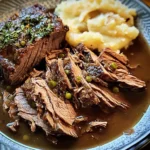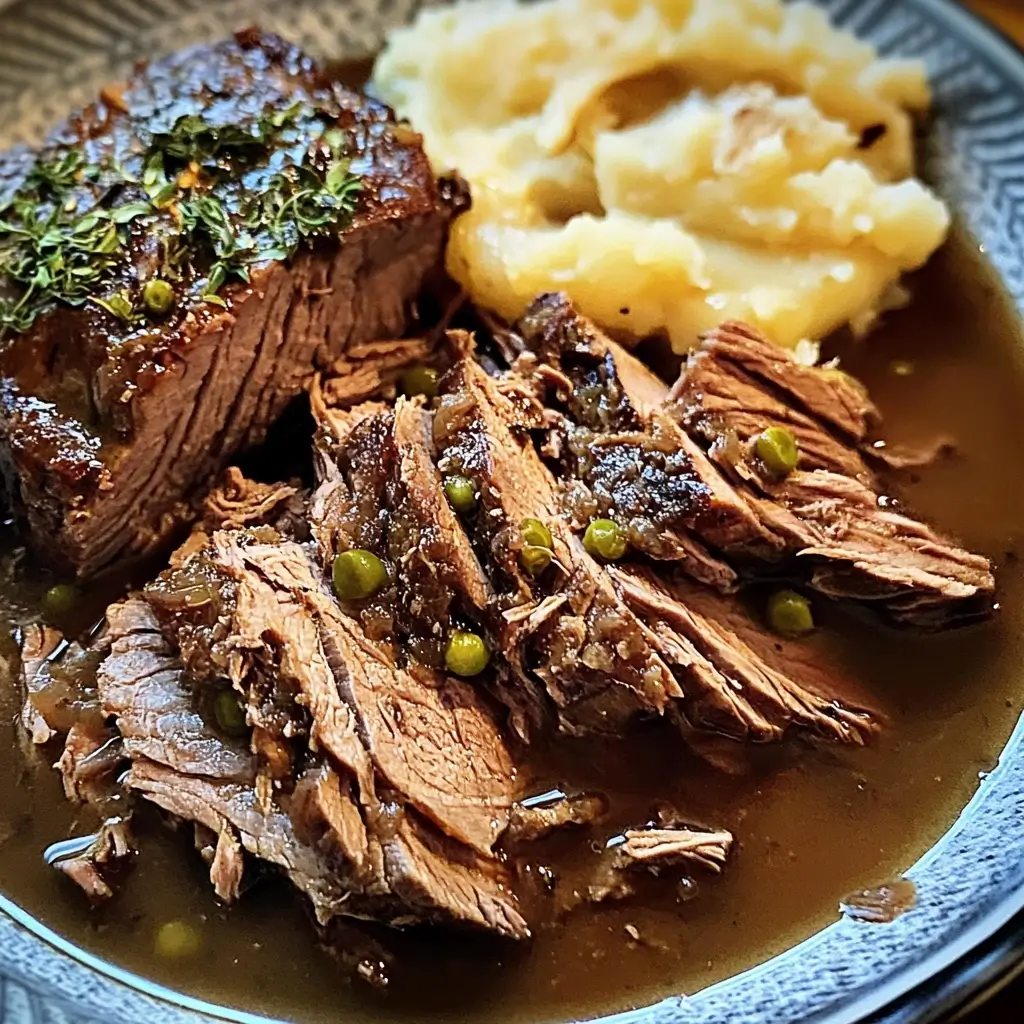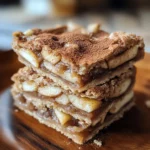There’s nothing quite like the aroma of slow-cooked beef wafting through the house, promising a comforting and satisfying meal. Recently, I decided to dust off my trusty slow cooker and try a London Broil recipe. Now, London Broil sometimes gets a bad rap for being tough, but let me tell you, cooked low and slow in a flavorful marinade, it transforms into something truly special. My family, usually picky eaters when it comes to beef, devoured this. The meat was incredibly tender, practically falling apart with a fork, and the marinade had permeated every fiber, creating a rich, savory flavor that was simply irresistible. Even my youngest, who usually just picks at her protein, asked for seconds! This Slow Cooker London Broil recipe has become a new family favorite, and I’m excited to share the secrets to achieving perfectly cooked, melt-in-your-mouth London Broil with minimal effort. Get ready to experience a weeknight dinner that feels like a weekend feast.
Ingredients
The beauty of this Slow Cooker London Broil lies in its simple yet impactful ingredients. The marinade is the star here, tenderizing the sometimes-tough London Broil and infusing it with layers of flavor. Let’s break down each component and why it’s crucial for creating a truly exceptional dish:
- London Broil (2-3 lbs): This is the star of the show. London Broil is a lean cut of beef, typically from the flank or top round. It’s known for its robust beefy flavor but can be tough if not cooked properly. Slow cooking is the perfect method to break down those tougher fibers and create incredibly tender results. When selecting your London Broil, look for a piece that is about 1-1.5 inches thick and has good marbling (flecks of fat within the lean meat). Marbling contributes to both flavor and moisture. If you can’t find London Broil, flank steak or top round roast can be used as substitutes, although cooking times may need slight adjustments.
- Soy Sauce (½ cup): Soy sauce is the foundation of our marinade, providing a salty, umami-rich base. It also aids in tenderizing the meat due to its enzymatic properties. Use low-sodium soy sauce if you are watching your salt intake, as the marinade already contains other salty ingredients. For a gluten-free option, use tamari or coconut aminos.
- Worcestershire Sauce (¼ cup): Worcestershire sauce is a flavor powerhouse, adding a complex blend of savory, tangy, and slightly sweet notes. It deepens the overall flavor profile of the marinade and complements the soy sauce beautifully. Don’t skip this ingredient; it truly elevates the dish.
- Olive Oil (¼ cup): Olive oil serves multiple purposes in the marinade. Firstly, it helps to emulsify the marinade, allowing the flavors to blend together seamlessly. Secondly, it coats the London Broil, helping the marinade adhere better and preventing the meat from drying out during the slow cooking process. Extra virgin olive oil is preferred for its richer flavor, but regular olive oil or even vegetable oil can be used.
- Red Wine Vinegar (¼ cup): Red wine vinegar introduces a crucial element of acidity to the marinade. Acidity is key to tenderizing tougher cuts of meat like London Broil. It breaks down muscle fibers, resulting in a more tender and palatable final product. Red wine vinegar also adds a bright, tangy counterpoint to the richness of the other marinade ingredients. If you don’t have red wine vinegar, apple cider vinegar or balsamic vinegar can be used as substitutes, although they will slightly alter the flavor profile.
- Garlic (4 cloves, minced): Garlic is a fundamental flavor enhancer in countless cuisines, and it’s no different here. Freshly minced garlic adds a pungent, aromatic depth to the marinade. The garlic flavor infuses into the London Broil during the slow cooking process, creating a savory and irresistible taste. For a stronger garlic flavor, you can use more cloves. Alternatively, you can use garlic powder if you don’t have fresh garlic on hand (about 1 teaspoon of garlic powder is equivalent to 1 clove of fresh garlic).
- Dijon Mustard (2 tablespoons): Dijon mustard adds a subtle tang and a bit of spice to the marinade. It also acts as an emulsifier, helping to bind the marinade ingredients together. Dijon mustard has a more complex and pronounced flavor than yellow mustard, making it a better choice for this recipe. If you don’t have Dijon mustard, stone-ground mustard can be used as a substitute.
- Dried Oregano (1 teaspoon): Dried oregano adds a warm, slightly peppery, and herbaceous note to the marinade. It complements the other savory flavors and adds a touch of Mediterranean flair. If you prefer, you can substitute other dried herbs like thyme, rosemary, or Italian seasoning. Fresh oregano can also be used, just double the amount (2 teaspoons fresh oregano).
- Dried Basil (1 teaspoon): Dried basil provides a sweet, slightly peppery, and aromatic flavor that pairs beautifully with beef and garlic. It adds another layer of complexity to the marinade and enhances the overall flavor profile. Similar to oregano, you can substitute other dried herbs or use fresh basil (again, double the amount).
- Black Pepper (1 teaspoon, freshly ground): Freshly ground black pepper adds a pungent, aromatic spice that is essential for balancing the flavors in the marinade. Freshly ground pepper has a brighter and more intense flavor than pre-ground pepper. Adjust the amount of pepper to your preference.
- Optional: Red Pepper Flakes (½ teaspoon): For those who like a little heat, red pepper flakes add a subtle kick to the marinade. They provide a gentle warmth that complements the other flavors without being overpowering. Adjust the amount of red pepper flakes to your spice preference, or omit them entirely if you prefer a milder flavor.
Instructions
Preparing Slow Cooker London Broil is incredibly straightforward. The slow cooker does most of the work, allowing you to enjoy a delicious and tender meal with minimal hands-on time. Here’s a step-by-step guide to ensure perfect results every time:
- Prepare the Marinade: In a medium-sized bowl, whisk together the soy sauce, Worcestershire sauce, olive oil, red wine vinegar, minced garlic, Dijon mustard, dried oregano, dried basil, black pepper, and red pepper flakes (if using). Ensure all ingredients are well combined and the marinade is emulsified. Tip: Whisking vigorously helps to blend the oil and vinegar together, creating a more cohesive marinade.
- Marinate the London Broil: Place the London Broil in a gallon-sized resealable plastic bag or a shallow dish. Pour the marinade over the beef, ensuring it is evenly coated. If using a bag, remove as much air as possible before sealing. If using a dish, turn the London Broil to coat both sides thoroughly. Tip: Marinating in a bag allows for better contact between the meat and marinade. You can also use a vacuum-seal bag for even better marinade penetration.
- Refrigerate and Marinate: Place the bag or dish with the marinated London Broil in the refrigerator. Marinate for at least 4 hours, or ideally overnight for maximum flavor and tenderness. The longer the marinating time, the more flavorful and tender the beef will become. Tip: For optimal results, marinate for 12-24 hours. If you are short on time, even 4 hours of marinating will make a significant difference.
- Sear the London Broil (Optional but Recommended): While this step is optional, searing the London Broil before slow cooking adds a beautiful crust and deepens the flavor. Remove the London Broil from the marinade and pat it dry with paper towels. Heat a tablespoon of olive oil in a large skillet over medium-high heat. Sear the London Broil on all sides for 2-3 minutes per side, until nicely browned. Tip: Searing locks in the juices and adds a rich, caramelized flavor to the beef. Don’t overcrowd the pan; sear in batches if necessary to ensure proper browning.
- Slow Cook the London Broil: Transfer the seared (or unseared) London Broil to your slow cooker. Pour the remaining marinade over the beef. Cover and cook on low for 6-8 hours or on high for 3-4 hours, or until the London Broil is fork-tender. Cooking times may vary slightly depending on your slow cooker and the thickness of the London Broil. Tip: For the most tender results, cook on low for a longer duration. The beef should easily shred with a fork when it’s done.
- Check for Doneness: To check for doneness, use a fork to gently pull apart the London Broil. It should shred easily and be very tender. If it’s still tough, continue cooking for another 30-60 minutes. You can also use a meat thermometer to check the internal temperature. For well-done London Broil, aim for an internal temperature of 160°F (71°C). However, because it’s slow-cooked, it will be tender even at this temperature. For a slightly less well-done result (but still safe and tender in a slow cooker), you could aim for 145°F (63°C) for medium-rare, but London Broil is often best cooked to well-done in a slow cooker for maximum tenderness. Tip: Slow cooking breaks down connective tissue, making London Broil incredibly tender even when cooked to well-done. Don’t worry about it drying out.
- Shred or Slice and Serve: Once the London Broil is cooked to your desired tenderness, remove it from the slow cooker and let it rest for 10 minutes before shredding or slicing against the grain. Resting allows the juices to redistribute throughout the meat, resulting in a more flavorful and moist final product. Tip: Slicing against the grain is crucial for tender London Broil. Identify the direction of the muscle fibers and slice perpendicular to them.
- Serve and Enjoy: Serve your Slow Cooker London Broil hot with your favorite sides. The flavorful cooking liquid in the slow cooker can be reduced slightly on the stovetop to create a delicious sauce to drizzle over the shredded or sliced beef. Tip: To make a sauce, strain the cooking liquid into a saucepan. Bring to a simmer over medium heat and cook until slightly reduced and thickened. You can also whisk in a cornstarch slurry (1 tablespoon cornstarch mixed with 2 tablespoons cold water) for a thicker sauce.
Nutrition Facts (Per Serving – Approximate)
(Note: Nutritional values are estimates and can vary based on specific ingredients and serving sizes.)
Serving Size: Approximately 4 ounces (113 grams) cooked London Broil
Calories per Serving: Approximately 250-300 calories
Approximate Breakdown:
- Protein: 30-35 grams
- Fat: 10-15 grams
- Saturated Fat: 3-5 grams
- Cholesterol: 80-90 mg
- Sodium: 500-700 mg (can vary based on soy sauce used)
- Carbohydrates: 5-7 grams (primarily from marinade ingredients)
- Fiber: 0-1 gram
- Sugar: 2-4 grams (naturally occurring and from marinade ingredients)
Important Considerations:
- These values are estimates and can vary based on the specific cut of London Broil, the brand of ingredients used, and the exact serving size.
- Using low-sodium soy sauce will significantly reduce the sodium content.
- Trimming excess fat from the London Broil before cooking can reduce the fat and calorie content.
- Serving size is crucial for accurate calorie and nutrient tracking.
This Slow Cooker London Broil is a relatively lean source of protein, rich in essential amino acids. It also provides iron, zinc, and B vitamins. Enjoy in moderation as part of a balanced diet.
Preparation Time
The hands-on preparation for this Slow Cooker London Broil is minimal, making it perfect for busy weeknights. Here’s a breakdown of the time involved:
- Prep Time: 15-20 minutes (This includes measuring and mixing the marinade ingredients, preparing the London Broil, and placing it in the marinade.)
- Marinating Time: Minimum 4 hours, ideally overnight (12-24 hours) – This is passive time where the flavors develop and the meat tenderizes in the refrigerator.
- Searing Time (Optional): 10-15 minutes (If you choose to sear the London Broil, this adds a little extra time.)
- Slow Cooker Cook Time: 6-8 hours on low, or 3-4 hours on high (This is also passive cooking time, allowing you to focus on other tasks while the slow cooker works its magic.)
- Resting Time: 10 minutes (Allowing the meat to rest after cooking is crucial for optimal tenderness and juiciness.)
Total Time (excluding marinating): Approximately 6 hours 35 minutes to 8 hours 45 minutes (on low, including searing and resting). Or approximately 3 hours 35 minutes to 4 hours 45 minutes (on high, including searing and resting).
Hands-On Time: Approximately 35-45 minutes (This is the active time you spend preparing the marinade, searing, and shredding/slicing the beef. The majority of the time is passive slow cooking and marinating.)
This recipe is fantastic for meal prepping. You can prepare the marinade and marinate the London Broil in advance. Then, on cooking day, simply sear (optional) and place it in the slow cooker. The minimal active time makes it a stress-free way to enjoy a delicious and satisfying beef dinner.
How to Serve Slow Cooker London Broil
The versatility of Slow Cooker London Broil is one of its greatest strengths. Whether you choose to shred it or slice it, it pairs wonderfully with a wide variety of sides and in numerous dishes. Here are some delicious serving suggestions:
Classic Sides:
- Mashed Potatoes: Creamy mashed potatoes are a quintessential pairing with beef. They soak up the flavorful juices and provide a comforting base for the tender London Broil.
- Roasted Vegetables: Roasted vegetables like carrots, potatoes, broccoli, or Brussels sprouts add color, nutrients, and a delightful textural contrast. Toss them with olive oil, herbs, and roast until tender and slightly caramelized.
- Green Beans: Sautéed or steamed green beans, perhaps with a touch of garlic or almonds, offer a simple and healthy side dish.
- Corn on the Cob: In the summer months, grilled or boiled corn on the cob is a perfect accompaniment to the robust flavor of London Broil.
- Side Salad: A fresh garden salad with a vinaigrette dressing provides a light and refreshing contrast to the richness of the beef.
Creative Serving Ideas:
- Shredded Beef Sandwiches: Pile shredded Slow Cooker London Broil onto toasted rolls or buns and top with your favorite sandwich fixings like coleslaw, pickles, onions, and BBQ sauce or the reduced cooking liquid for a flavorful and satisfying sandwich.
- Beef Tacos or Burritos: Use the shredded London Broil as a filling for tacos or burritos. Add your favorite toppings like salsa, guacamole, sour cream, cheese, and cilantro for a Tex-Mex inspired meal.
- Beef Bowls: Create customizable bowls with a base of rice, quinoa, or couscous, topped with shredded London Broil, roasted vegetables, and a flavorful sauce or dressing.
- Shepherd’s Pie Topping: Use the shredded London Broil as a rich and flavorful base for shepherd’s pie. Top with mashed potatoes and bake until golden brown for a comforting twist on a classic dish.
- Beef Stroganoff Inspired Dish: While not traditional stroganoff, you can create a creamy sauce with sour cream or Greek yogurt, mushrooms, and onions to serve over the shredded London Broil and noodles or rice.
Serving with the Cooking Liquid:
- Reduced Sauce: As mentioned earlier, the cooking liquid in the slow cooker is packed with flavor. Strain it into a saucepan and reduce it over medium heat to create a concentrated and delicious sauce to drizzle over the beef and sides.
- Au Jus: The reduced cooking liquid can also be served as an au jus for dipping sliced London Broil, providing extra moisture and flavor.
No matter how you choose to serve it, Slow Cooker London Broil is sure to be a crowd-pleaser. Its tender texture and rich flavor make it a versatile and satisfying main course for any occasion.
Additional Tips for Perfect Slow Cooker London Broil
To ensure your Slow Cooker London Broil is a resounding success every time, here are five essential tips to keep in mind:
- Don’t Skip the Marinade (and Marinate Long Enough): The marinade is absolutely crucial for tenderizing London Broil and infusing it with flavor. Don’t be tempted to shorten the marinating time. Aim for at least 4 hours, and ideally overnight (12-24 hours) for the best results. The longer marinating time allows the acids and enzymes in the marinade to break down tough muscle fibers, leading to incredibly tender beef.
- Searing Enhances Flavor (But is Optional): While not strictly necessary for tenderness in a slow cooker, searing the London Broil before slow cooking adds a significant layer of flavor complexity. The Maillard reaction, which occurs during searing, creates hundreds of flavor compounds that enhance the overall taste of the beef. If you have the extra time, searing is highly recommended.
- Don’t Overcook (But Slow Cooker is Forgiving): While slow cookers are generally forgiving, overcooking can still lead to slightly drier beef. Cook until the London Broil is fork-tender, meaning it shreds easily with a fork. Start checking for doneness around the recommended cooking time and adjust as needed based on your slow cooker and the thickness of the beef. However, due to the moisture and slow cooking method, it’s much less likely to dry out compared to other cooking methods.
- Rest the Meat After Cooking: Just like with any roast or steak, resting the London Broil after it comes out of the slow cooker is essential. Allow it to rest for at least 10 minutes before shredding or slicing. Resting allows the juices to redistribute throughout the meat, resulting in a more moist and flavorful final product. Tent it loosely with foil while resting to keep it warm.
- Slice Against the Grain (Always): London Broil, like flank steak and skirt steak, has very pronounced muscle fibers. To maximize tenderness, it is absolutely critical to slice against the grain. Identify the direction of the muscle fibers and slice perpendicular to them. This shortens the fibers, making the beef significantly more tender and easier to chew. If you slice with the grain, the beef will be noticeably tougher, even if it’s been slow-cooked.
Frequently Asked Questions (FAQ) about Slow Cooker London Broil
Here are five common questions and answers to help you master Slow Cooker London Broil:
Q1: Can I use a different cut of beef if I can’t find London Broil?
A1: Yes, while London Broil is the recommended cut, you can use flank steak or top round roast as substitutes. Flank steak is very similar to London Broil and will cook similarly. Top round roast is a slightly thicker cut and may require a bit longer cooking time. Adjust cooking times as needed to ensure the beef is fork-tender. Avoid using very lean cuts like sirloin tip roast, as they can become dry in the slow cooker.
Q2: Can I cook this on high instead of low?
A2: Yes, you can cook Slow Cooker London Broil on high for 3-4 hours instead of 6-8 hours on low. However, cooking on low is generally recommended for maximum tenderness and flavor development. Cooking on high may result in slightly less tender beef, but it will still be delicious and much faster. Be sure to check for doneness earlier when cooking on high, starting around the 3-hour mark.
Q3: Do I need to add any liquid besides the marinade to the slow cooker?
A3: No, you do not need to add any extra liquid beyond the marinade. London Broil releases its own juices as it cooks in the slow cooker. The marinade and the beef’s natural juices will create enough liquid to keep the meat moist and prevent it from drying out.
Q4: Can I add vegetables to the slow cooker with the London Broil?
A4: Yes, you can definitely add vegetables to the slow cooker along with the London Broil. Root vegetables like carrots, potatoes, and onions work particularly well as they can withstand the long cooking time. Place the vegetables in the bottom of the slow cooker and place the marinated London Broil on top. Keep in mind that the vegetables will absorb some of the marinade flavor and become very tender.
Q5: What’s the best way to store leftover Slow Cooker London Broil?
A5: Store leftover Slow Cooker London Broil in an airtight container in the refrigerator for up to 3-4 days. For best results, store it in the cooking liquid to keep it moist. You can reheat it in the microwave, in a skillet over medium heat with a little bit of the cooking liquid, or even back in the slow cooker on low until heated through. Leftover shredded London Broil is excellent for sandwiches, tacos, or adding to salads.
By following this recipe and these helpful tips, you’ll be well on your way to creating incredibly tender and flavorful Slow Cooker London Broil that your family and friends will rave about. Enjoy the ease and deliciousness of this set-it-and-forget-it meal!
Print
Slow Cooker London Broil Recipe
Ingredients
- London Broil (2-3 lbs): This is the star of the show. London Broil is a lean cut of beef, typically from the flank or top round. It’s known for its robust beefy flavor but can be tough if not cooked properly. Slow cooking is the perfect method to break down those tougher fibers and create incredibly tender results. When selecting your London Broil, look for a piece that is about 1-1.5 inches thick and has good marbling (flecks of fat within the lean meat). Marbling contributes to both flavor and moisture. If you can’t find London Broil, flank steak or top round roast can be used as substitutes, although cooking times may need slight adjustments.
- Soy Sauce (½ cup): Soy sauce is the foundation of our marinade, providing a salty, umami-rich base. It also aids in tenderizing the meat due to its enzymatic properties. Use low-sodium soy sauce if you are watching your salt intake, as the marinade already contains other salty ingredients. For a gluten-free option, use tamari or coconut aminos.
- Worcestershire Sauce (¼ cup): Worcestershire sauce is a flavor powerhouse, adding a complex blend of savory, tangy, and slightly sweet notes. It deepens the overall flavor profile of the marinade and complements the soy sauce beautifully. Don’t skip this ingredient; it truly elevates the dish.
- Olive Oil (¼ cup): Olive oil serves multiple purposes in the marinade. Firstly, it helps to emulsify the marinade, allowing the flavors to blend together seamlessly. Secondly, it coats the London Broil, helping the marinade adhere better and preventing the meat from drying out during the slow cooking process. Extra virgin olive oil is preferred for its richer flavor, but regular olive oil or even vegetable oil can be used.
- Red Wine Vinegar (¼ cup): Red wine vinegar introduces a crucial element of acidity to the marinade. Acidity is key to tenderizing tougher cuts of meat like London Broil. It breaks down muscle fibers, resulting in a more tender and palatable final product. Red wine vinegar also adds a bright, tangy counterpoint to the richness of the other marinade ingredients. If you don’t have red wine vinegar, apple cider vinegar or balsamic vinegar can be used as substitutes, although they will slightly alter the flavor profile.
- Garlic (4 cloves, minced): Garlic is a fundamental flavor enhancer in countless cuisines, and it’s no different here. Freshly minced garlic adds a pungent, aromatic depth to the marinade. The garlic flavor infuses into the London Broil during the slow cooking process, creating a savory and irresistible taste. For a stronger garlic flavor, you can use more cloves. Alternatively, you can use garlic powder if you don’t have fresh garlic on hand (about 1 teaspoon of garlic powder is equivalent to 1 clove of fresh garlic).
- Dijon Mustard (2 tablespoons): Dijon mustard adds a subtle tang and a bit of spice to the marinade. It also acts as an emulsifier, helping to bind the marinade ingredients together. Dijon mustard has a more complex and pronounced flavor than yellow mustard, making it a better choice for this recipe. If you don’t have Dijon mustard, stone-ground mustard can be used as a substitute.
- Dried Oregano (1 teaspoon): Dried oregano adds a warm, slightly peppery, and herbaceous note to the marinade. It complements the other savory flavors and adds a touch of Mediterranean flair. If you prefer, you can substitute other dried herbs like thyme, rosemary, or Italian seasoning. Fresh oregano can also be used, just double the amount (2 teaspoons fresh oregano).
- Dried Basil (1 teaspoon): Dried basil provides a sweet, slightly peppery, and aromatic flavor that pairs beautifully with beef and garlic. It adds another layer of complexity to the marinade and enhances the overall flavor profile. Similar to oregano, you can substitute other dried herbs or use fresh basil (again, double the amount).
- Black Pepper (1 teaspoon, freshly ground): Freshly ground black pepper adds a pungent, aromatic spice that is essential for balancing the flavors in the marinade. Freshly ground pepper has a brighter and more intense flavor than pre-ground pepper. Adjust the amount of pepper to your preference.
- Optional: Red Pepper Flakes (½ teaspoon): For those who like a little heat, red pepper flakes add a subtle kick to the marinade. They provide a gentle warmth that complements the other flavors without being overpowering. Adjust the amount of red pepper flakes to your spice preference, or omit them entirely if you prefer a milder flavor.
Instructions
- Prepare the Marinade: In a medium-sized bowl, whisk together the soy sauce, Worcestershire sauce, olive oil, red wine vinegar, minced garlic, Dijon mustard, dried oregano, dried basil, black pepper, and red pepper flakes (if using). Ensure all ingredients are well combined and the marinade is emulsified. Tip: Whisking vigorously helps to blend the oil and vinegar together, creating a more cohesive marinade.
- Marinate the London Broil: Place the London Broil in a gallon-sized resealable plastic bag or a shallow dish. Pour the marinade over the beef, ensuring it is evenly coated. If using a bag, remove as much air as possible before sealing. If using a dish, turn the London Broil to coat both sides thoroughly. Tip: Marinating in a bag allows for better contact between the meat and marinade. You can also use a vacuum-seal bag for even better marinade penetration.
- Refrigerate and Marinate: Place the bag or dish with the marinated London Broil in the refrigerator. Marinate for at least 4 hours, or ideally overnight for maximum flavor and tenderness. The longer the marinating time, the more flavorful and tender the beef will become. Tip: For optimal results, marinate for 12-24 hours. If you are short on time, even 4 hours of marinating will make a significant difference.
- Sear the London Broil (Optional but Recommended): While this step is optional, searing the London Broil before slow cooking adds a beautiful crust and deepens the flavor. Remove the London Broil from the marinade and pat it dry with paper towels. Heat a tablespoon of olive oil in a large skillet over medium-high heat. Sear the London Broil on all sides for 2-3 minutes per side, until nicely browned. Tip: Searing locks in the juices and adds a rich, caramelized flavor to the beef. Don’t overcrowd the pan; sear in batches if necessary to ensure proper browning.
- Slow Cook the London Broil: Transfer the seared (or unseared) London Broil to your slow cooker. Pour the remaining marinade over the beef. Cover and cook on low for 6-8 hours or on high for 3-4 hours, or until the London Broil is fork-tender. Cooking times may vary slightly depending on your slow cooker and the thickness of the London Broil. Tip: For the most tender results, cook on low for a longer duration. The beef should easily shred with a fork when it’s done.
- Check for Doneness: To check for doneness, use a fork to gently pull apart the London Broil. It should shred easily and be very tender. If it’s still tough, continue cooking for another 30-60 minutes. You can also use a meat thermometer to check the internal temperature. For well-done London Broil, aim for an internal temperature of 160°F (71°C). However, because it’s slow-cooked, it will be tender even at this temperature. For a slightly less well-done result (but still safe and tender in a slow cooker), you could aim for 145°F (63°C) for medium-rare, but London Broil is often best cooked to well-done in a slow cooker for maximum tenderness. Tip: Slow cooking breaks down connective tissue, making London Broil incredibly tender even when cooked to well-done. Don’t worry about it drying out.
- Shred or Slice and Serve: Once the London Broil is cooked to your desired tenderness, remove it from the slow cooker and let it rest for 10 minutes before shredding or slicing against the grain. Resting allows the juices to redistribute throughout the meat, resulting in a more flavorful and moist final product. Tip: Slicing against the grain is crucial for tender London Broil. Identify the direction of the muscle fibers and slice perpendicular to them.
- Serve and Enjoy: Serve your Slow Cooker London Broil hot with your favorite sides. The flavorful cooking liquid in the slow cooker can be reduced slightly on the stovetop to create a delicious sauce to drizzle over the shredded or sliced beef. Tip: To make a sauce, strain the cooking liquid into a saucepan. Bring to a simmer over medium heat and cook until slightly reduced and thickened. You can also whisk in a cornstarch slurry (1 tablespoon cornstarch mixed with 2 tablespoons cold water) for a thicker sauce.
Nutrition
- Serving Size: one normal portion
- Calories: 250-300
- Sugar: 2-4 grams
- Sodium: 500-700 mg
- Fat: 10-15 grams
- Saturated Fat: 3-5 grams
- Carbohydrates: 5-7 grams
- Fiber: 0-1 gram
- Protein: 30-35 grams
- Cholesterol: 80-90 mg





